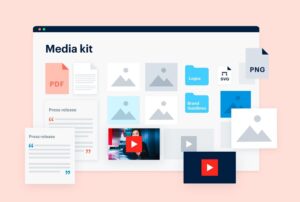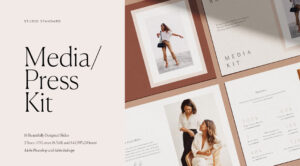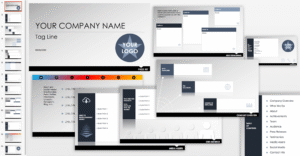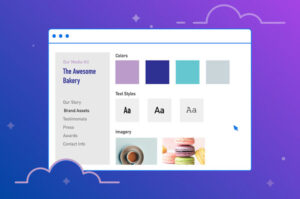What is a Media Kit?
What is a Media Kit? : A media kit is an essential element of any brand. Do you want to get your business noticed in the press? Who doesn’t? To achieve this goal, you need a top-notch media kit.
Don’t worry! You don’t need to hire a PR specialist or graphic designer. You can create a media kit using smart copywriting, free tools, and templates.
Make creating this kit a top priority for your business. It only takes a few hours but will pay off big time. Don’t wait until you launch a significant PR campaign to prepare and deliver a media kit. You must invest your time to be ready for any unexpected press opportunities.

In this article, we’ll show you how to quickly and easily create a media kit. Below, we’ll give you everything you need to create one. Plus, we’ll introduce you to top media kit examples to help you get creative.
This guide includes:
- What is a media kit?
- Why does every brand need a media kit?
- How to create a media kit in the new year
- Free media kit templates
- 4 top media kit examples to get inspired by
Also known as a press kit, a media kit is a collection of promotional materials that help journalists and bloggers write articles about your brand. This kit includes the following elements:
- Biography
- Contact information
- Logos
- Taglines
- Fonts
- Colors
- Mission Statement
- Product information
- Social handles
- Shareable graphics
- Branding dos and don’ts
- Case studies
- Partnerships
- Endorsements
- Business Statistics
Does that sound like too much? Of course, too much is not good! Your media kit should include the essential elements relevant to your business.
A media kit can include responsive pages on your website, downloadable PDFs, slideshows, or even a Google Drive or Dropbox folder.
The purpose of a media kit
A media kit is designed to help journalists and bloggers learn about your company so they can publish a quality article.

That’s the whole point of a media kit.
A media kit can have incredible benefits for your brand, but remember that its purpose is to make the job of the news media effortless. With that in mind, create a flawless media kit that the press will love to use.
“As newsrooms get smaller, it’s easier for journalists to do their jobs, especially if we’re focusing on earned media coverage,” says Spencer Anupol, senior director of public relations at Digital Ocean. That’s fine for most companies. A shareable, non-editable Google Drive or Dropbox folder should suffice. Just make sure it’s well-organized and labeled.
“As your business grows, you can build your media kit on your website. Consider executive photos and biographies, images or videos of your team and facilities, company logos and a simple guide, a company schedule, and a brief company history. If you want to go further, add statistics and research the company and the industry you serve. A great way to get the right kit is to consider the content a reporter would need to write a story.”
Why does every brand need a media kit?
A media kit helps you get press coverage even when you’re asleep. With this handy resource, you can automate your PR processes instead of constantly answering emails and phone calls. This saves you and your reporters valuable time and energy.
Another benefit is brand protection. Without a media kit, a reporter or blogger might be discouraged from writing a business story and will not bother to find logos, tags, statistics, and graphics. They’ll likely use an old logo and outdated information about your brand.

Having a media kit can prevent this from happening. A press kit is the first thing a writer will look for when writing about a business. If they can’t find one, they must turn to Google to gather the necessary data and information.
You’re missing out on the PR buzz if you don’t have a media kit.
How to Create a Media Kit in the New Year?
Now you know what a media kit is. But how do you create one that the press will love? Luckily, you already have everything you need; you must choose the correct elements and combine them well.
Media kits can be interactive and amazing or static and simple. There’s no right or wrong way to craft one. How you craft your kit will depend largely on your audience, industry, and the breadth of your interactions.
We recommend keeping it simple and containing the essentials. In this case, you have an accessible version to make a reporter’s job easier.
Branding
Reporters will likely want to use your company logo as a hero image or somewhere in the article. Once you’ve designed your logo, offer it in multiple sizes and resolutions so they don’t have to dig through your files.

Include a transparent background and a PNG version of your logo. This gives graphic designers more freedom to place it on different images.
Along with your branding, provide a concise, lightweight guide. This guide may include how to use your logo and examples of appropriate and inappropriate uses. Include HTML and hex color codes so the designer can add branding elements to an image or video.
Executive Headshots and Biographies
Everyone loves a behind-the-scenes story, and media outlets often use snippets of your executives’ biographies to add depth to their stories. They want to understand each key player’s role in the company and how they got there.
You can also include quotes from your executives in your kit, especially if they are their own words. This way, reporters can access quotable content for their stories even without conducting a one-on-one interview with an executive.
Include high-quality photos of all your executives in your media kit. If you don’t have any, get some. It takes less than 5 minutes to grab a phone, get the executive in front of a suitable background, and snap a good photo. If you want professional-looking photos, hiring a professional photographer can make your media kit more attractive.
Stock Photos and Videos
Reporters may want to use images or video elements of your product. Shoot short B-rolls of your office and daily activities. Include product images and stills in your media kit.

If you have a digital product, include screenshots of it. These shots could include dashboards and product features. If you have a product demo video, include that in your media kit.
Contact Information
Who should the media contact to get in touch with your business? Include their contact information. This is not a good place to list all your managers’ names, emails, phone numbers, and addresses. Please don’t do that.
Instead, provide the contact information for your press relations manager. If you’re working solo, include your contact information. If you have a PR or media relations manager, include their contact information.
Provide an active, accessible email address. That one is checked daily. Many press inquiries are time-sensitive and may not take more than 24 hours to respond.
Statistics and Research
Reporters love to use numbers. So give them everything you have. Share revenue, total customers, or social media followers if appropriate.
For example, let’s look at the New York Times media kit. The kit includes:

- News rankings
- Global digital readership
- Reader demographics
- Audience spending power
This information is compelling to potential advertisers; writers can incorporate it into their stories.
A brief company history
Give writers everything they need to give a brief history of your brand. A history is not an e-book or blog post about your brand. The company history section of a media kit should be a paragraph or two about the company’s core story, mission, and vision. Star or highlight any major milestones.

Add a link to your media kit if you have a more comprehensive history.
Endorsements
Include case studies, reviews, and customer testimonials here. Short, one-sentence quotes are fine here. That is, writers can copy and paste anything into their articles. If you have a more comprehensive case study on your website, condense it into a short paragraph and include a link for readers to read further. They may not have time to read the entire 1,000-word version.
Showcase awards, partner logos, and previous press coverage in this section.
Remember to update your media kit regularly. Add new descriptions, case studies, and product information. Also, revise old details, such as follower and customer counts.
Free Media Kit Templates
While you can build a media kit from scratch, we recommend saving time (and avoiding design headaches) by using a free media kit template. These templates provide a framework for building a media kit. All you have to do is enter your information.

Here’s a list of the best sources for finding free media kit templates:
- Canva
- Adobe Creative Cloud Express
- Visme
- net
- Lucidpress
These sources include downloadable media kit templates, some with drag-and-drop functionality. Practice with these free options before building a kit from scratch. They’ll likely already have the elements you need.
4 Top Media Kit Examples to Get Inspired By
Ready to see real-world examples of media kits? Here are a few of our favorites:
1. Fast Company Media Kit: The press kit has customer community stats, testimonials, social media following, and case studies.
2. GearJunkie Media Kit: GearJunkies has impressive stats (over 2 million monthly views) alongside partners like REI, Patagonia, The North Face, and more. They provide case studies, promotional details, and past collaborations.

3. Atlassian Press Kit: They provide SVG and PNG files for all logos. You can also find photos of executive staff, office images, and a company overview. All of this content is nicely packaged into one short, attractive page.
4. Asana Dropbox Press Kit: Asana uses Dropbox to host its press kit, an excellent example of a simple media kit. You can find executive photos, logos, product images, b-roll shots, fact sheets, and more in one easy-to-navigate folder.
Finally
Now that you know how to create a media kit, it’s time to get press coverage. Creating a kit isn’t just about attracting press executives. You should also use Instagram, Facebook, YouTube, and content marketing to get your brand in front of the right media outlets, journalists, and bloggers.
Source